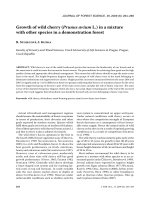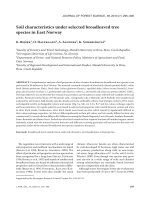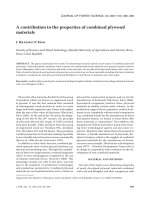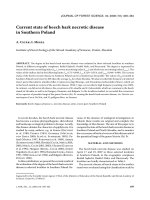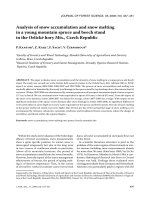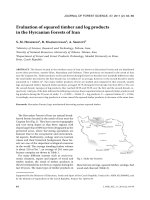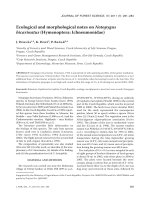Báo cáo lâm nghiệp: "Are ecophysiological responses influenced by crown position in cork-oak?" ppsx
Bạn đang xem bản rút gọn của tài liệu. Xem và tải ngay bản đầy đủ của tài liệu tại đây (527.32 KB, 7 trang )
Short
note
Are
ecophysiological
responses
influenced
by
crown
position
in
cork-oak?
G
Oliveira,
C
Werner,
O
Correia
Secçâo
de
Ecologia
e
Sistemática
dos
Vegetais,
Dep
de
Biologia
Vegetal,
Faculdade
de
Ciências
de
Lisboa,
Campo
Grande,
C2,
4°,
1700
Lisbon,
Portugal
(Received
31
October
1994;
accepted
18
July
1995)
Summary —
Montados
and
dehesas
of
Quercus
ilex
and
Quercus
suber
occupy
large
areas
in
the
Iberian
Peninsula
and
are
characterized
by
a
low-density
tree
cover.
The
variability
of
responses
within
tree
canopies
in
such
open
stands
has
been
little
studied.
We
investigated
the
variation
of
stom-
atal
conductance
within
the
crown
of
a
cork-oak
(Q
suber
L),
by
studying
its
diurnal
and
seasonal
courses
at
two
different
heights
and
four
directions
within
the
canopy.
Height
did
not
strongly
affect
leaf
response,
as
a
consequence
of
the
crown
structure.
Differences
were
found
in
microclimatic
conditions
and
maximum
stomatal
conductance
among
directions.
However,
overall
daily
stomatal
conductance
was
similar
among
different
crown
sections,
suggesting
that
leaves
develop
different
mechanisms
to
accomodate
the
microclimatic
constraints
which
affect
the
particular
position
they
occupy
in
the
crown
of
cork-oak.
cork-oak
/
isolated
tree
/
microclimate
/
stomatal
conductance
/
within-crown
variability
Résumé—
Les
réponses
écophysiologiques
sont-elles
influencées
par
la
position
des
feuilles
dans
la
couronne
du
chêne-liège ?
Les
montados
etdehesas
de
Quercus
ilex
et Quercus
suber
consti-
tuent
une
partie
importante
du
couvert
végétal
de
la
péninsule
Ibérique
et
se
caractérisent
par
une
basse
densité
d’arbres.
La
variabilité
de
réponses
au
sein
des
canopées
de
ces
arbres
a
été
peu
étudiée
jusqu’à
présent.
L’évolution
journalière
et
saisonnière
de
la
conductance
stomatique
à
différentes
hauteurs
et
expositions
a
été
étudiée
au
sein
de
la
canopée
d’un
chêne-liège
(Q
suber
L).
La
hauteur
n’a
pas
influencé
la
réponse
des
feuilles.
En
revanche,
on
a
trouvé
des
différences
entre
les
orientations
étu-
diées
du
point
de
vue
des
conditions
microclimatiques
et
des
conductances
maximales.
Cependant
la
conductance
stomatique
journalière
était
similaire
entre
les
sections
considérées,
ce
qui
suggère
que
les
feuilles
développent
des
mécanismes
différents
pour
faire
face
aux
contraintes
microclimatiques
selon
la
position
spécifique
qu’elles
occupent
dans
la
canopée.
arbre
isolé / chêne-liège / conductance
stomatique / microclimat / variabilité
dans
la
canopée
INTRODUCTION
A
tree
crown
may
be
seen
as a
large
and
heterogeneous
population
of
branches
and
leaves,
unequally subjected
to
environ-
mental
factors.
It
is
thus
questionable
if
stud-
ies
on a
few
leaves
or
a
branch
will
be
ade-
quate
to
represent
the
whole
canopy.
This
is
especially
important
in
the
field,
where
the
application
of
ecophysiological
measure-
ments
to
large
trees
presents
obvious
methodological
and
financial
problems.
Most
studies
on
the
gas
exchange
and
water
relations
of
Mediterranean
tree
species
are
restricted
to
young
and
small
individuals
(eg,
Tenhunen et
al,
1984;
Rhi-
zopoulou
and
Mitrakos,
1990;
Acherar
et
al,
1992),
or
to
a
limited
area
of
the
mature
tree
crown
(eg,
Lo
Gullo
and
Salleo,
1988;
Oliveira
et
al,
1992),
often
the
one
exposed
to
the
highest
radiation
levels.
Although
this
sort
of
sampling
may
be
useful
for
many
purposes,
and
the
only
one
possible
in
most
cases,
it
is
of
little
use
in
canopy
models
in
which
variation
within
the
canopy
is
impor-
tant
(Dolman
and
van
den
Burg,
1988;
Hollinger,
1989).
Unfortunately
only
a
few
reports
are
available
concerning
within-
canopy
variability
in
tree
species.
Height
in
the
canopy
influences
stomatal
response
(Dolman
and
van
den
Burg,
1988;
Sala,
1992)
and
photosynthetic
capacity
(Hollinger,
1989),
apparently
due
to
the
microclimate
gradient
developed
from
upper
to
lower
canopy
levels
in
closed
forests.
Quercus
suber
L
is
a
main
component
of
the
typical
montados
and
dehesas
in
the
Iberian
Peninsula
and
one
of
the
most
important
forest
species
occurring
in
Por-
tugal.
The
most
striking
feature
of
these
oak
stands
is
their
savanna-like
structure.
Tree
density
is
low
(generally
<
100.ha
-1
)
and
there
is
no
strong
competition
for
light.
Trees
are
seldom
higher
than
10 m,
and
develop
large
and
wide
crowns.
Probably
as
a
con-
sequence
of
their
growth
and
branching
pat-
terns
(Oliveira
et
al,
1994),
cork-oaks
pre-
sent
rather
diffuse
crowns,
and
typical
’shade-leaves’
(not
directly
sunlit)
are
thus
rare.
Considering
these
characteristics,
one
might
ask
if
within-crown
variability
exists
in
such
trees
and,
in
case
it
does,
what
are
the
sources
of
that
variation.
To
address
such
questions,
we
studied the
effects
of
different
positions
within
the
crown
on
the
ecophysiology
of
a
typical
mature
cork-oak
in
southwest
Portugal.
MATERIALS
AND
METHODS
The
study
took
place
at
the
Herdade
do
Pinheiro,
Portugal
(38°28’N,
8°42’W,
altitude
27
m).
The
stand
is
dominated
by
Q
suber
L
and
explored
for
pasture
and
cork
production.
The
study
years
(1992
and
1993)
were
drier
than
usual,
with
an
annual
rainfall
of
ca
370
mm.
Data
were
collected
monthly,
from
March
to
September.
The
studies
were
performed
on
a
single
cork-
oak,
representative
of
the
stand
and
sufficiently
isolated
to
prevent
significant
shading
from
neigh-
bouring
trees.
The
selected
tree,
with
a
stem
cir-
cumference
of
0.60
m
(at
1.30
m),
was
10 m
high
and
its
crown
diameter
averaged
13 m.
Catwalks
and
towers
were
built
around
the
tree
in
order
to
give
access
to
branches
in
four
directions
(north,
east,
south
and
west)
and
two
heights
of
the
canopy:
middle,
at
5.5
m
(M)
and
low,
at
3
m
(L).
Diurnal
courses
of
stomatal
conductance
(g
s
),
photosynthetic
photon
flux
density
incident
on
the
leaf
(PPFD
i
),
air
temperature
(Tair),
and
air-to-
leaf
water
vapour
pressure
difference
(VPD)
were
determined
with
a
steady-state
porometer
(LI-
1600,
Li-Cor
Lincoln,
NE,
USA).
Readings
were
taken
from
three
fully
expanded
leaves
from
dif-
ferent
branches
in
each
height
and
direction
(sec-
tion),
at
the
periphery
of
the
crown.
The
same
leaves
were
measured
throughout
the
year,
whenever
possible.
Simultaneous
determinations
of
water
potential
on
neighbouring
terminal
shoots
were
made
with
a
pressure
chamber.
Differences
among
heights
and
directions
were
tested
for
the
measured
parameters,
at
each
date,
with
two-factor
analyses
of
variance.
Most
results
and
discussions
hereafter
will
only
refer
to
north
and
south
directions,
which
appeared
to
represent
the
canopy
response
extremes
for
the
studied
parameters.
RESULTS
AND
DISCUSSION
Although
rainfall
had been
scarce
in
the
pre-
vious
autumn
and
winter
months,
water
availability
to
the
tree
was
high
during
the
study
period,
as
indicated
by
the
predawn
water
potential
values
(-0.2/-0.5
MPa,
fig
1A).
No
relevant
differences
in
minimum
daily
water
potential
values
were
found,
nei-
ther
between
M
and
L
levels
(not
shown),
nor
between
north
and
south
sections
(fig 1A).
The
PPFD
i
was
significantly
affected
by
direction,
but
generally
not
by
height
in
the
crown
(table
I;
fig
1 B).
However,
some
sig-
nificant
interactions
between
direction
and
height
are
suggested
by
the
results.
Tair
and
VPD
were
rather
homogeneous
within
the
crown
and
only
showed
a
few
differ-
ences
among
directions
(table
I).
Stomatal
conductance
was
also
more
sig-
nificantly
affected
by
direction
than
by
height
within
the
canopy,
during
spring
(table
I).
New
leaves
emerged
in
May,
and
their
dif-
ferent
development
stage
within
the
crown
probably
contributed
to
the
significant
dif-
ferences
among
directions
observed
in
this
month.
As
the
dry
season
progressed,
gs
decreased,
and
no
differences
were
found
among
directions
for
the studied
parame-
ters
(fig
1 B and
C;
table
I).
These
results
are
different
from
those
found
for
Q
robur
(Dolman
and
van
den
Burg,
1988),
where
the
stomatal
response
varied
with
the
height
in
the
crown,
but
more
similar
to
the
ones
reported
for
an
isolated
Q
alba
tree
(Aubu-
chon
et
al,
1978).
Maximum
annual
stomatal
conductance
varied
among
the
different
parts
of
the
crown,
decreasing
in
the
sequence
east -
south -
west -
north
(table
II).
They
were
recorded
during
spring,
and
generally
in
the
morning,
when
VPD
and
Tair
were
below
21
Pa.kPa
-1
and
28 °C,
respectively.
Light
(PPFD
i)
did
not
seem
to
play
a major
role
in
the
maximum
gs
measured
in
the
field.
What
prevents
all
leaves
from
attaining,
and
maintaining
for
longer
periods,
these
high
stomatal
conductances?
Light,
the
envi-
ronmental
factor
which
was
different
over
the
canopy,
was
apparently
not
the
main
restriction,
since
high
conductances
were
measured
under
relatively
low
levels
of
PPFD
i
(<700
μE.m
-2.s-1
,
table
II).
More-
over,
higher
light
intensities
occurred
throughout
the
day,
without
an
increase
in
stomatal
conductance.
This
was
probably
due
to
the
increase
in
Tair
and
VPD
which
apparently
became
more
limiting
to
gs
than
PPFD
i
after
the
first
morning
hours.
In
fact,
the
compromise
VPD/Tair/PPFD
i
differed
among
crown
sections
as
the
sun
angle
changed
throughout
the
day
and
the
year.
It
could thus
be
expected
that
east
and
south
exposed
leaves
would
be
"favoured"
because
early
in
the
day,
when
their
water
potential
is
high,
the
evaporative
demand
is
low,
and
they
receive
enough
light
for
photosynthesis.
But
do
leaves
contribute
differently
to
overall
canopy
productivity
according
to
their
position
in
the
crown?
Previous
observa-
tions
showed
that
south
and
west
produced
more
branches
and
leaves
(although
smaller)
than
the
other
sections
of
the
crown
(Oliveira
et
al,
1993).
However,
despite
the
fact
that
south-facing
leaves
generally
attained
higher
maximal
conductances
(table
II;
fig
1C),
their
daily
stomatal
contribution
was
not
much
different
from
that
of
north
leaves
(fig
2).
This
was
because
south
leaves
were
exposed,
not
only
to
the
most
suitable
environmental
conditions
(in
the
morning),
but
generally
also
to
the
strongest
environmental
demand
(highest
PPFD
i
and
VPD,
in
the
early
afternoon).
Rhizopoulou
et
al
(1991)
found
that
sun
and
shade
leaves
from
Mediterranean
species
seem
to
have
developed
avoidance
or
tolerance
mechanisms,
respectively,
to
withstand
their
particular
microclimatic
con-
ditions.
Although
the
north
leaves
in
our
study
are
not
characteristic
shade
leaves,
our
results
appear
to
support
that
view.
Dif-
ferent
photosynthetic
capacities
within
the
canopy
(Hollinger,
1989)
might
explain
the
high
physiological
performance
of
north-
exposed
leaves
under
less
favourable
con-
ditions
than
the
rest
of
the
crown.
In
agreement
with
other
studies
(Rhi-
zopoulou
et
al,
1991;
Sala,
1992),
within-
crown
variability
was
reduced
during
sum-
mer
(table
I),
when
environmental
conditions
became
more
critical
(fig
1).
It
is
worth
not-
ing
that
it
was
during
the
intensive
growth
period
(spring)
that
differences
among
crown
sections
were
apparent.
CONCLUSION
Microclimate
varied
more
with
direction
than
with
height
within
the
crown
of
the
studied
tree.
Accordingly,
height
in
the
crown
did
not
greatly
affect
stomatal
conductance
in
this
oak.
It
might
be
argued
that
the
sam-
pled
crown
heights
were
not
sufficiently
dif-
ferent,
and
that
higher
branches
(eg,
at
9
m)
would
probably
show
different
responses
when
compared
to
the
lower
ones.
Even
though
this
could
be
true,
we
believe
that
such
differences
would
be
small,
due
to
the
crown’s
size.
Moreover,
in
these
oaks,
the
largest
proportion
of
leaves
is
located
at
the
sampled
levels
and
although
the
’low’
branches
get
occasionally
shaded
during
the
day
by
those
above
them,
the
’middle’
branches
do
not.
Direction
within
the
crown
influenced
maximum
gs
values.
This
seemed
to
depend
on
the
compromise
among
optimal
envi-
conditions
(PPFD
i,
VPD
and
Tair)
and
on
the
time
of
day
it
occurred.
However,
daily
stomatal
contribution
was
similar
in
all
sections
of
the
canopy,
as
a
consequence
of
different
leaf
performances
according
to
position
in
the
crown.
On
the
other
hand,
within-crown
variability
was
not
evident
during
periods
of
stronger
environ-
mental
stress.
Although
this
is
a
case
study
performed
on
a
single
tree,
it
is
a
first
approach
to
the
sources
of
variation
affecting
leaf
perfor-
mance
in
isolated
trees.
These
results,
together
with
those
previously
reported
on
inter-tree
variability
(Oliveira
et
al,
1992,
1994),
should
be
taken
into
account
when
planning
field
research
in
similar
stands.
Moreover,
this
work
may
provide
some
use-
ful
information
for
future
modelling
of
oak
productivity
in
these
woodlands.
ACKNOWLEDGMENTS
We
are
grateful
to
the
owners
of
H
Pinheiro
for
permission
to
work
on
their
property,
and
to
all
our
colleagues
who
helped
in
the
field
work.
This
research
was
supported
by
JNICT
grant
BD/1630-
IE
given
to
G
Oliveira,
and
is
part
of
the
project
MOST,
financed
by
EU-Environment
Programme
EV 5V-CT92-0210.
REFERENCES
Acherar
M,
Rambal
S,
Lepart
J
(1991)
Évolution
du
poten-
tiel
hydrique
foliaire
et
de
la
conductance
stomatique
de
quatre
chênes
méditerraneens
lors
d’une
période
de dessèchement.
Ann Sci
For 48,
561-576
Aubuchon
RR,
Thompson
DR,
Hinckley
TM
(1978)
Envi-
ronmental
influences
on
photosynthesis
within
the
crown
of
a
white
oak .
Oecologia
35,
295-306
Dolman
AJ,
van
den
Burg
GJ
(1988)
Stomatal
behaviour
in
an
oak
canopy.
Agric
For
Meteorol
43, 99-108
Hollinger
DY
(1989)
Canopy
organization
and
foliage
photosynthetic
capacity
in
a
broad-leaved
evergreen
montane
forest.
Funct
Ecol 3,
53-62
Lo
Gullo
MA,
Salleo
S
(1988)
Different
strategies
of
drought
resistance
in
three
Mediterranean
sclero-
phyllous
trees
growing
in
the
same
environmental
conditions.
New Phytol
108, 267-276
Oliveira
G,
Correia
OA,
Martins-Loução
MA,
Catarino
FM
(1992)
Water
relations
of
cork-oak
(Quercus
suber L)
under
natural
conditions.
Vegetatio 99-100,
199-208
Oliveira
G, Werner C,
Mertens C,
Correia
O (1993)
Influ-
encia
de
la
posición
de
la
copa
sobre
la
fenología
y
las
relaciones
hidricas
del
alcornoque
(Quercus
suber
L).
In:
Proceedings
Congreso
Forestal
Español-Lourizán
1993
(FJ
Silva-Pando,
G
Vega
Alonso, eds), vol
1, 277-282
Oliveira
G,
Correia
O,
Martins-Loução
MA,
Catarino
FM
(1994)
Phenological
and
growth
patterns
of
the
Mediterranean
oak
Quercus
suber L.
Trees
9,
41-
46
Rhizopoulou
S,
Mitrakos
K
(1990)
Water
relations
of
evergreen
scierophylls.
I.
Seasonal
changes
in
the
water
relations
of
eleven
species
from
the
same
environment.
Ann
Bot
65,
171-178
Rhizopoulou
S,
Meletiou-Christou
MS,
Diamantoglou
S
(1991)
Water
relations
for
sun
and
shade
leaves
of
four
Mediterranean
evergreen
sclerophylls.
J
Exp
Bot
42, 627-635
Sala
A
(1992)
Water
relations,
canopy
structure,
and
canopy
gas
exchange
in
a
Quercus
ilex forest:
vari-
ation
in
time
and
space.
Thesis,
Universitat
de
Barcelona,
Barcelona,
Spain
Tenhunen
JD,
Lange
OL,
Gebel
J,
Beyschlag
W,
Weber
JA
(1984)
Changes
in
photosynthetic
capacity,
car-
boxylation
efficiency,
and
CO
2
compensation
point
associated
with
midday
stomatal
closure
and
mid-
day
depression
of
net
CO
2
exchange
of
leaves
of
Quercus suber.
Planta
162,
193-203

